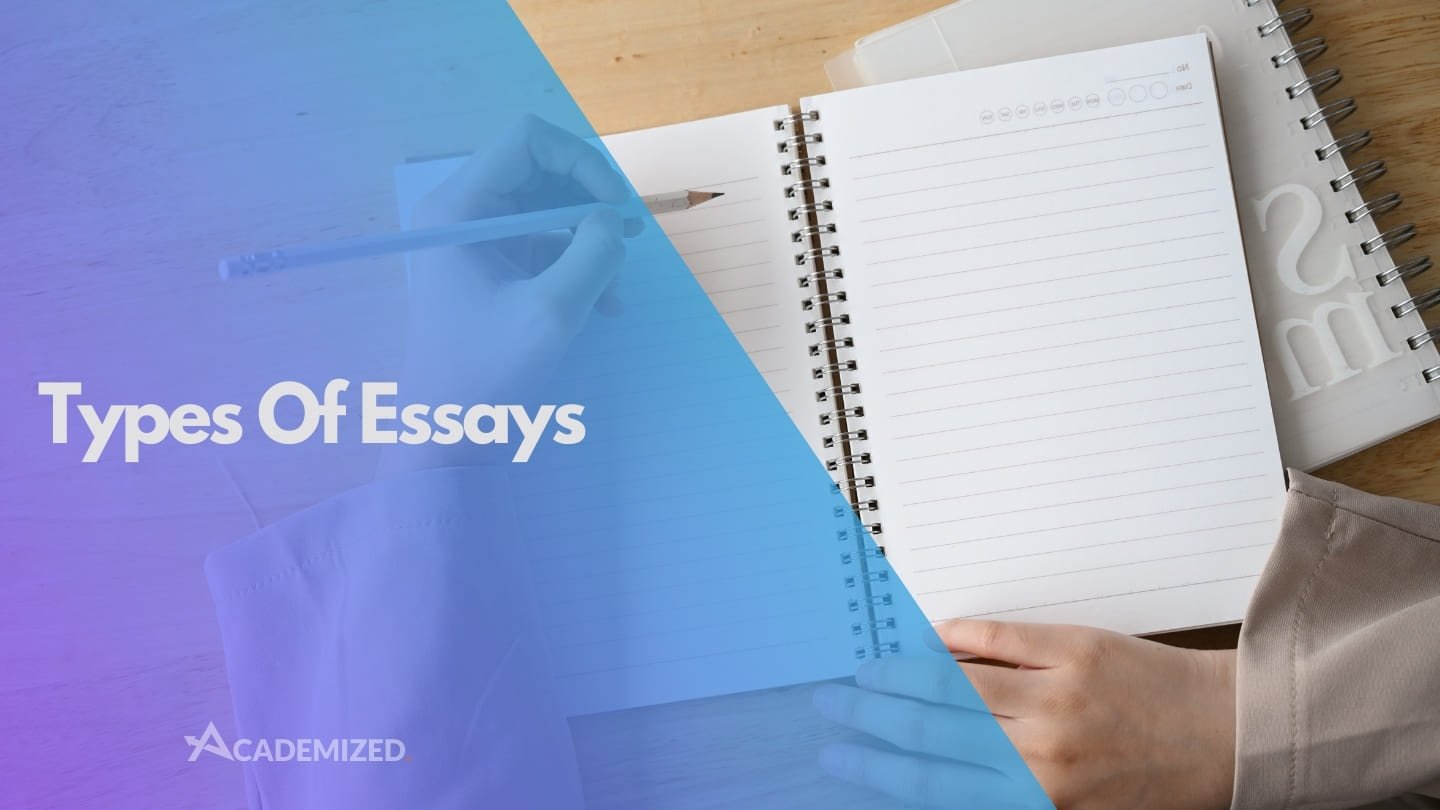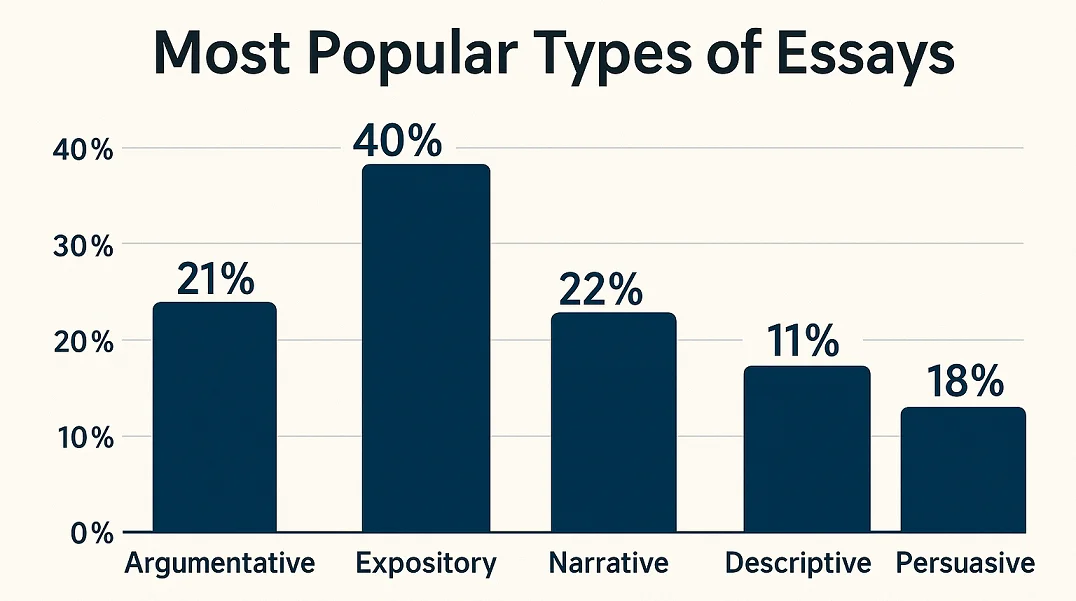- Blog
- All Types of Essays: Learn How to Write Each One
All Types of Essays: Learn How to Write Each One
 Mary Watson
Mary Watson

Understanding academic writing begins with recognizing the various forms it can take. Many assignments follow specific structures designed to fulfill different purposes. There are several ways to classify written work, but most fit within a few major categories. There are many different types of essays, but they can be separated into five main categories: argumentative, expository, narrative, descriptive, and persuasive essays. Each format serves a distinct goal, whether explaining an idea, sharing a story, presenting an argument, or describing an experience.
Composing an effective essay starts with selecting the proper approach. The purpose of an assignment often determines which structure to follow. Certain subjects require detailed explanations, while others emphasize logical reasoning or creativity. Each format has guidelines that help organize thoughts and improve clarity.
Some compositions mix multiple strategies to strengthen their impact. For example, a persuasive argument may include vivid descriptions, or an informative piece might use storytelling elements. Regardless of which method a writer chooses, keeping ideas well-structured improves readability and engagement.
Writing effectively requires familiarity with various techniques. When students explore multiple formats, they gain confidence in their abilities and refine their communication skills. Learning how to develop ideas within a structured framework builds strong writing habits. Mastering these approaches prepares individuals for different academic challenges and professional tasks.
5 Main Types of Essays
It is generally accepted that academic writing includes five main types of essays:
- Argumentative
- Expository
- Narrative
- Descriptive
- Persuasive
Academic assignments typically follow one of several established formats. Each serves a particular goal, helping writers convey their message clearly. Understanding these essay types allows students to organize their thoughts and develop strong written content.

Argumentative Essay
The goal of an argumentative paper is to present a well-reasoned case. Writers support a claim using facts, logic, and credible sources. A structured approach ensures clarity, with each paragraph dedicated to reinforcing the main position. Addressing opposing viewpoints strengthens arguments by demonstrating awareness of different perspectives.
Example: "Social media has reshaped communication, yet its impact on mental health remains debated. While some argue that digital platforms enhance connectivity, research shows that prolonged use can increase anxiety. Studies indicate that excessive scrolling leads to unrealistic comparisons, affecting self-esteem. Establishing a balance between online engagement and real-world interactions helps maintain emotional well-being."
Expository Essay
An expository paper defines itself by explaining a subject in a straightforward way. Writers provide clear information, often breaking down complex topics into manageable points. Objective analysis and supporting details help readers understand concepts without bias. Well-organized paragraphs guide audiences through each point logically.
Example: "The process of photosynthesis plays a crucial role in sustaining life on Earth. Plants absorb sunlight, converting energy into food through a chemical reaction involving carbon dioxide and water. Oxygen, released as a byproduct, supports respiration in living organisms. This natural cycle maintains ecological balance and ensures survival for countless species."
Narrative Essay
A narrative essay is based on telling a personal story or recounting an event. This format allows creativity while still maintaining a clear structure. A strong introduction sets the scene, while the body develops the plot. Effective storytelling engages the reader by using descriptive language and personal insights.
Example: "As I stood on the edge of the diving board, my heart pounded. The water below shimmered, waiting for my decision. Years of hesitation had led to this moment. With a deep breath, I jumped. The instant rush of adrenaline gave way to exhilaration as I broke through the surface. Overcoming fear had never felt so rewarding."
Descriptive Essay
Creating a vivid picture through words is the focus of a descriptive essay. Writers use sensory details to bring subjects to life, helping readers experience what is being described. Thoughtful word choice and detailed observations enhance the overall impression, making the subject feel real and tangible.
Example: "The autumn forest stretched endlessly, a golden mosaic of rustling leaves. Crisp air carried the scent of pine, mingling with the earthy aroma of damp soil. Sunlight filtered through the branches, casting shifting patterns on the winding path. Each step crunched beneath my boots, harmonizing with the quiet symphony of nature."
Persuasive Essay
Convincing an audience to accept a particular viewpoint defines persuasive writing. This style relies on emotional appeal, logical arguments, and strong examples. A compelling introduction captures interest while supporting details strengthen the argument. Effective persuasion combines facts with engaging language to influence readers' opinions.
Example: "School uniforms promote unity among students, reducing peer pressure based on clothing choices. By eliminating fashion-based competition, academic focus improves. Studies suggest that dress codes lead to fewer distractions in classrooms, enhancing overall performance. Encouraging a standardized dress policy fosters equality, allowing students to concentrate on learning rather than appearance."
Specialized Types of Essays
Academic writing extends beyond the basic structures most students recognize. Some assignments require a specific format designed to explore ideas in greater detail or analyze concepts from multiple angles. Such academic tasks are usually more complex, so students often outsource their writing to an essay service. For those learners who prefer to handle their academic assignments personally, understanding these specialized formats enhances their writing skills and prepares them for various learning challenges. Knowing what are the different types of essays ensures that each task is approached with the correct structure and purpose.
Discursive Essay
A discursive essay presents multiple perspectives on a topic, allowing the reader to consider different viewpoints before reaching a conclusion. Writers explore various arguments, presenting balanced reasoning rather than supporting a single stance. This format is commonly used in debates and discussions where neutrality is valued.
Example: "The impact of social media on human interaction remains widely debated. Some argue that online platforms strengthen global connections, enabling instant communication. Others contend that excessive use leads to social isolation and reduced face-to-face engagement. Evaluating both sides helps individuals understand the broader implications of technology in everyday life."
Profile Essay
A profile essay offers an in-depth look at a person, place, or event, providing readers with detailed insights. Unlike a biography, this format focuses on unique qualities and experiences that define the subject. Writers rely on observations, interviews, and research to create a vivid and informative narrative.
Example: "Dr. Lisa Carter, a leading neuroscientist, has dedicated her career to studying memory retention. Her groundbreaking research on cognitive function has influenced educational practices worldwide. Speaking with her reveals a passion for understanding the human brain, as well as a commitment to making scientific discoveries accessible to students."
Position Essay
A position essay requires writers to take a clear stance on a controversial issue, supporting their perspectives with evidence and logic. Unlike discursive writing, which explores multiple sides, this format argues in favor of a single viewpoint. Strong examples and credible sources reinforce the argument.
Example: "Renewable energy should replace fossil fuels as the primary source of power. Studies show that wind and solar energy reduce environmental harm and provide sustainable alternatives. Governments must prioritize green technology investments to mitigate climate change and ensure long-term energy security."
Reaction Paper
A reaction paper provides a personal analysis of a specific text, film, or event. Rather than summarizing content, writers reflect on key themes and express individual interpretations. This style encourages thoughtful evaluation and deeper engagement with the subject matter.
Example: "The novel '1984' by George Orwell presents a chilling vision of a surveillance-driven society. The themes of government control and restricted freedoms resonate in today’s digital era. Reading this dystopian classic prompted me to consider the ethical implications of mass data collection in modern life."
Definition Essay
A definition essay is among the types of essay writing that explore a concept or term beyond its dictionary meaning. Writers examine how interpretations evolve based on culture, history, and personal experiences. Abstract ideas such as success, freedom, or happiness often serve as subjects for this type of analysis.
Example: "Success is more than financial achievement; it reflects personal fulfillment and growth. While some define success through career advancements, others see it in meaningful relationships and personal well-being. Understanding different perspectives on success helps individuals set goals that align with their values."
Process Essay
A process essay explains the steps needed to complete a task or understand a concept. Writers organize instructions in a clear sequence, ensuring that readers can follow the process easily. These essays are common in how-to guides and academic explanations.
Example: "Baking a perfect chocolate cake requires careful preparation. Start by preheating the oven to the recommended temperature. Next, mix flour, sugar, and cocoa powder in one bowl while beating eggs and butter in another. Gradually combine the wet and dry ingredients, stirring until smooth. Pour the batter into a greased pan and bake until a toothpick inserted in the center comes out clean."
Response Essay
A response essay focuses on personal reflections. Unlike a reaction paper, which primarily critiques content, this format allows the writer to share their thoughts, opinions, and connections to the material. Among the different essay types, response essays stand out for their emphasis on personal interpretation and individual perspective, making them a valuable tool for expressing unique insights.
Example: "Watching the documentary on climate change reinforced my awareness of environmental issues. Seeing the effects of pollution on marine life made me reconsider my own habits. Reducing plastic use and supporting sustainable products became a personal commitment after learning about the long-term impact of waste."
Exploratory Essay
An exploratory essay investigates a question or problem without taking a firm stance. Instead of arguing for one side, the writer examines different perspectives and considers possible solutions. This format encourages deep thinking and research which some students struggle with. Those learners may choose to get custom essays for sale instead of writing their own exploratory papers. That said, mastering this essay type will make you a more skilled and confident writer.
Example: "The rise of artificial intelligence raises ethical concerns regarding job security and privacy. While some argue that automation increases efficiency, others fear it will replace human workers. Exploring the balance between innovation and employment protection can help shape future policies."
Illustrative Essay
An illustrative essay uses examples to explain or clarify a concept. Among the different kinds of essays, this format relies on real-life instances to make abstract topics easier to understand. Writers support their ideas with concrete evidence, strengthening their arguments and enhancing comprehension for the reader.
Example: "Community service benefits students in multiple ways. Volunteering at shelters teaches empathy by exposing individuals to different life experiences. Assisting in food drives fosters teamwork and social responsibility. These activities shape character while contributing to society."
Synthesis Essay
A synthesis essay combines information from multiple sources to present a comprehensive viewpoint. Writers analyze various texts, identifying connections and drawing conclusions based on gathered evidence.
Example: "The debate over renewable energy highlights conflicting perspectives. Scientific studies emphasize its environmental benefits, while critics point to high initial costs. Comparing research from energy experts, policymakers, and economists allows for a well-rounded understanding of sustainable solutions."
Informative Essay
An informative essay educates the reader on a specific topic by providing facts, explanations, and analysis. Among the types of essays in middle school, this format helps students develop research and organizational skills. Writers focus on delivering well-organized content without expressing personal opinions.
Example: "The water cycle plays a crucial role in maintaining Earth’s ecosystem. Evaporation from oceans and lakes forms clouds through condensation. These clouds release precipitation, which replenishes water bodies and nourishes plant life. Understanding this natural process helps explain weather patterns and environmental sustainability."
Reflective Essay
A reflective essay allows writers to examine personal experiences and their impact. This format encourages deep thought and self-awareness, connecting past events to present perspectives.
Example: "Volunteering at a local shelter changed my outlook on community service. Initially, I saw it as just an obligation, but interactions with residents made me realize the importance of compassion. The experience taught me that small actions can make a significant difference in someone’s life."
Critical Essay
A critical essay analyzes a piece of literature, art, or media, evaluating its strengths and weaknesses. This format requires strong reasoning skills and evidence-based arguments.
Example: "Shakespeare’s 'Hamlet' explores themes of betrayal, morality, and revenge. The protagonist’s internal struggles highlight the complexities of human nature. By examining his soliloquies, readers gain insight into his psychological turmoil and philosophical dilemmas."
Cause and Effect Essay
A cause-and-effect essay explains how one event leads to another, helping readers understand the relationships between actions and outcomes. Writers structure these essays by presenting clear connections between causes and their consequences.
Example: "Deforestation contributes to climate change by increasing greenhouse gas emissions. Trees absorb carbon dioxide, and their removal results in higher atmospheric levels. This process accelerates global warming, leading to rising temperatures and extreme weather events."
Compare and Contrast Essay
A compare and contrast essay examines similarities and differences between two or more subjects. Writers present balanced analyses to highlight key distinctions and connections.
Example: "Traditional classrooms and online learning both offer educational benefits. While in-person settings provide direct teacher interaction, virtual platforms offer flexibility. Understanding these differences helps students choose the learning environment that best suits their needs."
Analytical Essay
An analytical essay dissects a subject into smaller parts to examine how each component contributes to the whole. Writers often apply this format when discussing literature, historical events, or scientific studies. Strong arguments are built using evidence, reasoning, and interpretation.
Example: "In 'To Kill a Mockingbird,' Harper Lee explores themes of justice and morality through the perspective of Scout Finch. The symbolic role of the mockingbird illustrates the innocence destroyed by prejudice. By analyzing Atticus Finch’s courtroom speech, we can see how Lee critiques societal bias and challenges readers to reflect on ethical responsibility."
Problem Solution Essay
Problem-solution essays identify an issue and propose practical ways to address it. In these types of college essays, writers explain the problem, discuss potential solutions, and evaluate their effectiveness.
Example: "Urban traffic congestion creates significant environmental and economic challenges. Expanding public transportation, implementing carpooling incentives, and promoting cycling could reduce road congestion. By investing in sustainable transit systems, cities can improve air quality and enhance daily commutes for residents."
Evaluation Essay
An evaluation essay critically assesses a subject based on specific criteria. Writers examine the strengths and weaknesses of books, movies, policies, or products to form a reasoned judgment. This format helps students develop their analytical abilities.
Example: "The latest adaptation of 'Pride and Prejudice' captures the novel’s essence while modernizing certain elements. The cinematography highlights the period’s beauty, but some character portrayals lack depth. By comparing this adaptation with previous versions, we can assess how different interpretations impact audience perception."
Classification Essay
A classification essay organizes subjects into distinct categories based on shared characteristics. This format helps writers break down broad topics into understandable sections.
Example: "College students can be classified into three learning styles: visual, auditory, and kinesthetic. Visual learners benefit from diagrams and charts, while auditory learners retain information through lectures. Kinesthetic learners engage best with hands-on activities. Understanding these categories allows students to optimize their study methods."
Rhetorical Analysis Essay
A rhetorical analysis essay examines how an author or speaker persuades an audience. This can be relevant for all types of essays. Writers evaluate word choice, emotional appeal, and logical arguments to understand the message's effectiveness.
Example: "In his 'I Have a Dream' speech, Martin Luther King Jr. uses repetition, imagery, and emotional appeals to inspire unity. By analyzing his rhetorical techniques, we can see how he reinforces his vision of equality and motivates social change."
Personal Essay
A personal essay provides insight into the writer’s experiences, thoughts, and emotions. This format allows for self-reflection and personal storytelling while often conveying a broader message or lesson. Writers use vivid descriptions and personal anecdotes to engage readers.
Example: "Growing up in a small town, I never imagined the impact a single teacher could have on my life. Ms. Johnson’s encouragement and belief in my abilities inspired me to pursue writing. Her influence still shapes my determination and passion for storytelling today."
Scholarship Essay
A scholarship essay highlights a student’s achievements, aspirations, and need for financial assistance. This format requires compelling storytelling, clear goals, and a strong connection to the scholarship’s purpose.
Example: "From a young age, I have been fascinated by medical research. Watching my grandmother struggle with diabetes fueled my ambition to become a doctor. Pursuing this career requires dedication and resources, and this scholarship will help me take the next step toward my goal of improving healthcare accessibility."
Admission Essay
An admission essay presents an applicant’s qualifications, experiences, and personal values to a college or university. These kinds of essays must be authentic and well-structured, showcasing why the writer is a strong candidate for the institution.
Example: "Attending XYZ University has been my dream since I first visited the campus. The innovative learning environment and focus on hands-on experience align perfectly with my passion for engineering. I look forward to contributing my problem-solving skills and creativity to the program."
Diagnostic Essay
A diagnostic essay assesses a student’s writing ability by responding to a prompt within a limited timeframe. Instructors use this format to evaluate strengths and areas for improvement without assigning a grade.
Example: "Technology’s role in education continues to evolve, changing how students access information. Online learning platforms provide flexibility but also require self-discipline. While traditional classrooms offer structure, digital resources enhance accessibility. Understanding these dynamics is crucial for shaping future learning experiences."
Satirical Essay
A satirical essay uses humor, irony, and exaggeration to critique societal issues. In these essay structure types, writers use wit to highlight flaws in politics, culture, or daily life while encouraging readers to think critically.
Example: "In today’s world, smartphones have become an extension of our hands. Conversations now involve more screen time than eye contact. The next logical step? Replacing traditional handshakes with emoji exchanges. After all, nothing says sincerity like a well-placed thumbs-up emoji."
Philosophy Paper
A philosophy paper explores abstract concepts, logical arguments, and ethical dilemmas. Writers analyze theories, construct well-reasoned viewpoints, and support claims with philosophical reasoning. This type of writing requires critical thinking and a structured presentation of ideas.
Example: "The concept of free will has long been debated by philosophers. While determinists argue that human actions are influenced by external forces, others claim that individuals have the ability to make independent choices. Examining the works of Kant and Sartre reveals how different perspectives shape our understanding of moral responsibility."
Historiographical Essay
A historiographical essay examines how historians have interpreted an event over time. Writers compare sources, highlight differing viewpoints, and analyze trends. This format helps students understand how interpretations evolve based on new evidence and cultural shifts.
Example: "The American Revolution has been analyzed through various lenses. Early historians emphasized political ideals, while recent scholars explored economic and social factors. Comparing these perspectives reveals how historical narratives shift over time, reflecting contemporary values and emerging research."
Ethnographic Essay
An ethnographic essay documents and analyzes cultural practices, traditions, or social behaviors. Writers conduct fieldwork, including observations and interviews, to provide a detailed account of a specific group or community.
Example: "Spending time in a rural farming village provided insight into daily routines shaped by tradition. Conversations with local families highlighted the significance of communal work passed down through generations. Observing these customs revealed how shared responsibilities strengthen social bonds and preserve cultural heritage."
Technical Essay
Among all the types of essays in high school, a technical essay is rarely assigned at that level because of its complexity. Such an essay explains complex processes, concepts, or innovations in a clear and structured manner. Writers use precise language and logical sequencing to convey information effectively. This type of writing is common in scientific, engineering, and technological fields.
Example: "The advancement of artificial intelligence has transformed various industries. Machine learning algorithms analyze vast amounts of data, enabling systems to recognize patterns and improve decision-making. Understanding these developments is essential for grasping how technology continues to shape modern society."
Memoir Essay
Memoir essays share personal experiences while reflecting on their significance. Unlike an autobiography, which covers an entire life, these essay writing types focus on specific moments that shaped the writer’s perspective. Sensory details and emotions enhance the storytelling.
Example: "The summer I spent at my grandparents’ cabin changed my outlook on life. Mornings began with the scent of pine and the sound of birdsong. Evenings were filled with stories by the fireplace. Those quiet moments taught me to appreciate simple joys, leaving a lasting imprint on my memories."
Writing Tips Common to All Essay Types
Strong writing skills improve every essay, no matter the format. Following essential guidelines ensures clarity, organization, and engagement. These tips apply to all academic writing and help students refine their work.
- Start with a Clear Thesis: A well-defined thesis statement sets the direction for the entire essay. It should be specific, concise, and directly related to the topic. A strong thesis keeps the content focused and provides a foundation for supporting arguments.
- Organize Ideas Logically: When working with most forms of essays, note that each paragraph should have a clear purpose and connect smoothly to the next. Using an outline before writing can help structure thoughts in a logical order. Transitions between sections create a seamless reading experience.
- Use Reliable Evidence: Supporting claims with credible sources strengthens arguments. Citing academic research, expert opinions, and factual data adds credibility to the discussion. Avoiding unsupported opinions ensures a well-balanced and persuasive essay.
- Maintain a Consistent Tone: Matching the tone to the purpose of the essay enhances readability. A formal tone suits academic papers, while a personal touch works well for reflective or memoir essays. Keeping the language appropriate for the audience is also important.
- Edit and Revise Carefully: Revising multiple times helps refine ideas, correct errors, and improve clarity. Reading the essay aloud can highlight awkward phrasing. Using tools like grammar checkers or seeking feedback from peers ensures polished final drafts.
From My Own Experience
For me, writing essays has been a journey full of trial and error. I still remember the first time I had to write an argumentative paper – I thought throwing in big words would make me sound more convincing. Turns out, that only made my papers harder to read. Over time, I realized that clarity always wins over complexity when working with different types of writing essays.
One of the biggest game-changers for me was learning how to outline before writing. In high school, I used to dive straight into drafting, only to end up with a messy, unorganized piece. When I finally started jotting down key points and arranging them logically, my writing became much smoother. It also saved me a lot of time when revising.
Another lesson I picked up was the power of feedback. Early on, I was hesitant to share my work, fearing criticism. But the first time a professor gave me constructive notes on structure and argumentation, I saw immediate improvement. Now, I always ask a peer or mentor to glance at my drafts before finalizing them.
Deadlines have also been a struggle. Procrastination makes writing stressful, and rushing at the last minute never results in my best work. When I started breaking essays into smaller tasks – brainstorming one day, drafting the next, and then editing later – the process became way more manageable.
At the end of the day, writing is a skill that gets better with practice. The more types of essay structures you work with, the better your academic writing will get. I’ve made mistakes, but each one taught me something valuable. Whether it’s planning ahead, seeking feedback, or just keeping things clear and simple, these habits have made all the difference. And if you're struggling with essays, trust me – small changes in approach can lead to big improvements.
FAQ
What type of essay is the easiest to write?
Among all the types of academic essays, a narrative essay is often considered the easiest because it allows for storytelling and personal expression. Since there are fewer strict rules compared to other formats, writers can focus on engaging their audience with descriptive language and relatable experiences.
What is the hardest type of essay to write?
An argumentative or analytical essay can be challenging due to the need for strong reasoning and evidence. Writers must present structured arguments while also addressing the counterpoints. These essays require extensive research and logical thinking to build a convincing case.
What kind of essays do you have to write in high school?
High school students typically write various types of essays, including narrative, expository, persuasive, and literary analysis essays. Assignments focus on developing evaluative thinking, structure, and writing fluency to prepare students for more complex academic work.
What types of essays are commonly required in college and university?
At the college and university level, students frequently encounter research-based essays, argumentative essays, analytical essays, and compare-and-contrast essays. Higher education assignments demand deeper analysis, structured arguments, and properly cited sources.
Where can I find examples of different types of essays?
Many reputable academic websites, university writing centers, and online educational platforms provide essay types examples. Checking sources such as Purdue OWL, Khan Academy, and college writing labs can offer clear examples and formatting guidance.

Mary, our exceptional editor and online tutor, brings a wealth of knowledge to the table. With her extensive expertise in academic writing, she guides and mentors aspiring students, providing them with constructive feedback that propels their essays to the next level.


 Mary Watson
Mary Watson

